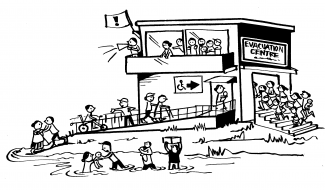Evacuation
Leaving no-one behind during an emergency response requires inclusive preparedness and risk reduction work as well as evacuation measures.
Making sure that evacuation mechanisms are inclusive requires preparation. Simulations or role play exercises where persons without disabilities take the role of persons with disabilities should be avoided. The following actions will ensure a proper preparation for evacuation:
- Prior identification of individuals who may need assistance to evacuate, in each community;
- Set-up a buddy system during preparedness phase;
- Train rescue teams, persons with disabilities and their family and caregivers in order to know how to work with persons with disabilities during an evacuation, using proper communication and attitudes ; make sure they understood the need for persons with disabilities to bring their assistive devices and medication;
- Evacuation routes and paths have to be properly designed respecting accessibility measures;
- Timely information and accessible early warning systems are crucial;
- Evacuation shelters or collective centres have to be accessible to everyone.
When evacuating people, do not forget to:
- Ask the person how you can best assist them in evacuating the area,
- Make sure to bring along assistive devices and medication,
- Apply a respectful attitude and communication manner when supporting persons with disabilities to ensure everyone understands and can act quickly.

©Julie Smith
Sources
IFRC, CBM and Handicap International. All Under One Roof. Disability-inclusive shelter and settlements in emergencies. IFRC. 2015.
Handicap International Nepal. Mainstreaming Disability into Disaster Risk Reduction - Training manual. 2009.